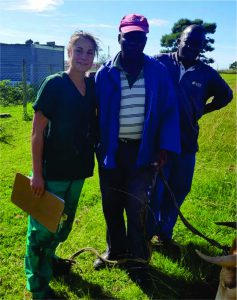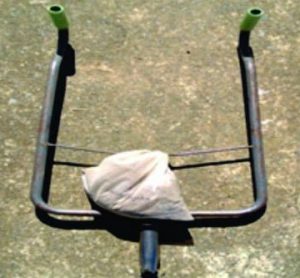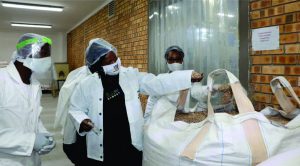Covid-19-disaster-fund
Covid-19 Agricultural Disaster Fund
THE MEC for the Department of Rural Development and Agrarian Reform Nomakhosazana Meth today handed over vouchers to farmers as part of the Covid-19 Agricultural Disaster Fund set up to ensure sustainable food production during and post the Covid-19 pandemic. Through the Department of Agriculture, Land Reform and Rural Development government allocated R1,2 billion to assist smallholder and communal farmers across the country.
Briefing the MEC ahead of the handover, Department of Agriculture, Land Reform and Rural Development Acting Chief Director, Dudu Nghona said the amounts given to farmers varied according to the needs of the farmers. Elated MEC Meth said the vouchers were life changing to farmers who had been negatively impacted by the Covid-19 pandemic. “Now that the farmers have received this funding, life will never be the same for them. I am glad that we also have young people who have benefited out of this.
” Chairperson of the Eastern Cape Poultry Farmers Association Mhlobo Mbane said he was grateful for the funding and urged the department to conduct strict monitoring and evaluation so as to ensure that the vouchers were used for what they are meant for. He also thanked the Department’s Extension and Advisory Services for ensure that farmers received the applications on time even under strict Level 5 lockdown regulations. Another farmer, Nonkululeko Nduzulwana who runs a poultry and piggery farm in Buffalo City Metro received vouchers to the tune of R50 000. She said the vouchers would be used to buy more broilers and pumps for the farm. Nduzulwana’s farm supplies ANCA Poultry in Stutterheim with eight-week-old chicks every two months.
“We are grateful for the support we have received. The vouchers will go a long way in supporting us to buy more broilers and other supplies for the farm. Our dream is to increase our capacity to 300 000 because we have the market and demand,” said Nduzulwana. 72-year-old Myra Nogaga who runs a farm of 1000 layers said she really needed “this support. I feel ‘wow’. I have joy in my heart. We had experienced hardships during the lockdown because our layers died as we could not access feed. I lost about 10% of my layers. Now with these vouchers worth R50 000, I will be able to buy more. I am very grateful to government for this intervention.
” Out of the farmers who received vouchers was also 19-yearold Nomagcinandile Suduka who runs a small poultry farm in Great Kei Municipality. The teenager said she was elated to have receive vouchers to boost her poultry enterprise. “I’m going to buy more chickens as I have already build structures to accommodate more chickens. With these vouchers I will buy 100 more chickens”. Of the10618 applications in the province, 1622 applications were successful 556 of which were women while 217 were youths.
The total amount to be issued to farmers amounts to R65 694 654. Reasons for non-approval stem from non-compliance with the criteria such as the number of years in farming, proof of access to land, annual turnover from agricultural enterprise activities of not less than R 20 000, number of jobs created by the enterprise and proof of access to markets. To date the total number of 2612 vouchers for 875 applicants have been received. The vouchers are meant to buy feed, medication, fertiliser, and chemicals depending on the commodity of each applicant.
EASTERN CAPE DEPARTMENT OF RURAL DEVELOPMENT AND AGRARIAN REFORM
SINCE the outbreak of COVID-19 that rapidly turned into a global pandemic, the agricultural sector is among those that were hard hit and subsequently, interventions were made by the government to alleviate the threatening effects. The assistance to the sector started with a R 1,2 billion disaster agricultural support fund from the national Department of Agriculture, Land Reform and Rural Development. The R1,2 billion was shared among all the country’s nine provinces and benefited a total of 1630 farmers in the Eastern Cape. To this date 1505 vouchers have been issued to farmers whose applications were successful. The applicants that did not qualify were reconsidered in phases two and three. In the Eastern Cape the distribution of the vouchers is managed by the Department of Rural Development and Agrarian Reform (DRDAR).The DRDAR has also been making strides to ensure smooth running of the agricultural sector for sustainable food security. This saw the department distributing Personal Protective Equipment (PPE) to farmers across the province. The effects of COVID-19 have worsened the situation of the already struggling agricultural sector in the province. And to this end the department has developed what it has termed a ‘Sector Recovery Plan’ which includes giving support to household through he household security programme where 10 000 households were identified to receive agricultural inputs.. DRDAR is also supporting crop farmers with production inputs and mechanization for various commodities including maize, vegetables, citrus, deciduous fruit, pineapples, chicory and blue berries. The budget allocated for these crops amounts to R 107-million targeting 21 191 hectares of arable land.








